Qualcomm Intros Snapdragon X Plus, Details Complete Snapdragon X Launch Day Chip Stack
by Ryan Smith on April 24, 2024 9:15 AM ESTSnapdragon X Plus: Second Verse, A Bit Less Than the First
Alongside today’s announcement of the Snapdragon X chip SKUs and the Snapdragon X Plus branding, Qualcomm put together a short presentation on the Snapdragon X Plus. Given that the underlying hardware is identical to the Snapdragon X Elite, there’s not much to talk about here in terms of technology or technical specs.
But ahead of the mid-year hardware launch, Qualcomm is providing some fresh performance slides, comparing the Snapdragon X Plus to its current-generation competition from Intel and AMD, as well as Qualcomm’s own Snapdragon X Elite. As with all vendor-provided benchmarks, these should be taken with a grain of salt. But if nothing else, it’s notable here what Qualcomm is and isn’t saying.
With 10 high-IPC CPU cores, Qualcomm should fare well in multi-threaded workloads, and this is exactly what they’re opting to promote. According to the company, the Snapdragon X Plus has a significant edge in both performance and power consumption at iso-power and iso-performance respectively. In the case of Cinebench 2024MT, that’s a 28% performance advantage over the Core Ultra 7 155H, or matching that chip’s peak performance at 39% lower power consumption.
Notably, however, what you won’t find from Qualcomm is any material promoting Snapdragon X Plus’s single-threaded performance versus any competition. With those peak clockspeeds of 3.4GHz, the Plus isn’t in a very favorable position versus the 4.8GHz Core Ultra 7 155H, even with what is presumably an IPC advantage.
As far as Qualcomm’s own chips are concerned, the Elite understandably has the advantage at any point on the curve in these MT tests. For a given architecture, a larger number of CPU cores is always the more energy efficient options, never mind the Elite’s clockspeed advantage on top of that. In any case, Qualcomm’s own figures put the Plus at about 15% behind the flagship Elite in Geekbench, and around 20% behind in Cinebench.
The company is also touting an advantage in GPU performance. Though as the benchmark in question is 3DMark Wildlife Extreme, a bencehmark that Qualcomm has already optimized for forwards, backwards, and upside-down within their drivers, I’m more interested in seeing how more PC-exclusive workloads perform. Though to Qualcomm’s credit, they’re no stranger to that space either, as they’ve been shipping Windows-on-Arm Snapdragon SoCs for several years now.
Snapdragon X Plus: Live and In Person
Finally, alongside briefing the press on the Snapdragon X Plus, Qualcomm also had some devices using the new chip SKU to show off, demonstrating the performance of the chip. This setup was similar to Qualcomm’s Snapdragon Summit preview event for the Snapdragon X Elite in October, albeit a bit more free-wheeling and hands-on now that the hardware is a bit more mature and there’s less of a chance of something going awry.
As with that preview event, Qualcomm has equipped their own internal reference design laptops with the chips. With its lower performance, all of the Snapdragon X Plus systems were the “config B” system, which is Qualcomm’s thin-and-light reference design, sporting a 14.5-inch OLED screen and designed for a total system TDP of 23 Watts.
| Qualcomm Snapdragon X Reference Test Systems (Thin and Light) | ||
| AnandTech | Snapdragon X Elite (X1E-80-100) |
Snapdragon X Plus (X1P-65-100) |
| 2 Core Max Turbo | 4.0GHz | 3.4GHz |
| All Core Max Turbo | 12C @ 3.4GHz | 10C @ 3.4GHz |
| GPU | 3.8 TFLOPS | 3.8 TFLOPS |
| RAM | LPDDR5X-8448 | LPDDR5X-8448 |
| Display | 14.5-inch OLED 2880x1800 |
14.5-inch OLED 2880x1800 |
| Thickness | 15mm | 15mm |
| Device TDP | 23W | 23W |
| Cooling | Active | Active |
| Battery | 58Wh | 58Wh |
The Elite version of this laptop was running the X1E-80-100 chip (the same chip as last time) which features a reduced performance GPU, a peak dual-core CPU clockspeed of 4.0GHz, and an all-core turbo of 3.4GHz. Meanwhile the Plus system has an identical GPU and all-core turbo clockspeed, but only 10 CPU cores with a peak dual-core CPU clockspeed of 3.4GHz.
As before, these systems were pre-configured with major benchmarks selected by Qualcomm, including Geekbench 6.2, Cinebench 2024, UL Proycon, PCMark 10, 3DMark, Blender, and new-to-Windows-on-Arm, Chrome. Qualcomm did let us touch these machines this time around, but these demos are still primarily being hosted to prove that Qualcomm is achieving the performance figures they claim.
On that note, here’s a quick rundown of Qualcomm’s performance claims, and what we observed for the Plus in action.
| Qualcomm Snapdragon X Benchmark Scores (Thin and Light) | ||||
| AnandTech | Elite - QC Expected Range | Plus - Observed | Plus - QC Expected Range | Plus vs Elite Performance |
| Cinebench 2024 ST | 121-123 | 109 | 107-109 | 89% |
| Cinebench 2024 MT | 920-980 | 860 | 825-845 | 86% |
| Geekbench 6.2 ST | 2750-2800 | 2420 | 2400-2425 | 87% |
| Geekbench 6.2 MT | 14200-14400 | 13049 | 12800-13100 | 91% |
| Chrome - Speedometer 2.1 | 450-470 | 426 | 410-430 | 91% |
| Chrome - JetStream 2.1 | 310-320 | N/A | 280-290 | 91% |
| PCMark 10 Applications | 12800-13200 | N/A | 12500-12800 | 97% |
| UL Procyon - Office Productivity | 6200-6500 | N/A | 5700-5900 | 91% |
| UL Procyon - AI CV Inference | 1750-1800 | N/A | 1750-1800 | 100% |
| 3DMark Wildlife Extreme | 37.1-38.5 fps | 37.1 | 37.1-38.5 fps | 100% |
| Blender (CPU) | 380-410 | N/A | 340-360 | 88% |
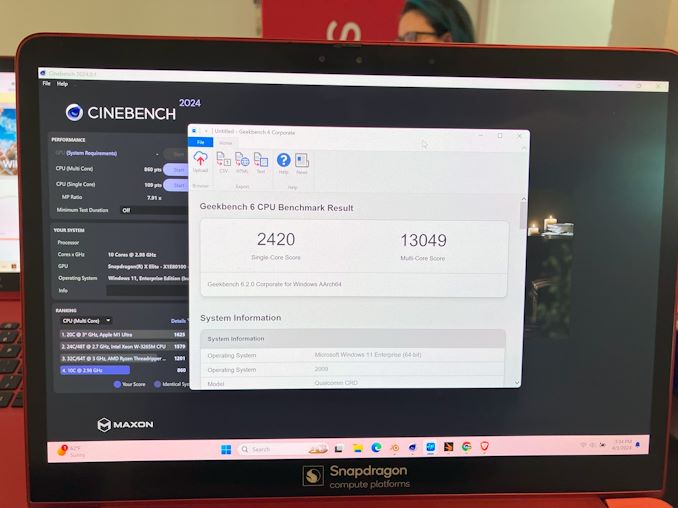
Geekbench 6.2 & Cinebench 2024
And with a little hands-on time, I even convinced Qualcomm’s representative to run the newer Speedometer 3.0 test on Chrome, which has just come out and was not yet part of their official benchmark suite. It scored 22.8.
Notably, here, the Snapdragon X Plus is closer in performance than what clockspeeds alone would predict. In Qualcomm’s supplied benchmark results, the Plus is never more than 14% behind in multithreaded workloads, and 13% behind in single-threaded workloads. And most of the time, it’s a 10% difference or less.
The 23 Watt system-wide TDP limit of the Qualcomm reference system is relatively constraining, all things considered. So I would not be the least bit surprised if the Snapdragon X Elite is being held back, in part, by not being able to run faster within Qualcomm’s systems. In other words, this is a more real-world test, as opposed to testing peak-to-peak unbounded by TDP concerns.
Overall, I don’t know if anything presented with the Snapdragon X Plus thus far would be considered all that surprising. With Qualcomm making their biggest push into the PC market yet, it makes perfect sense that they’re introducing multiple SKUs – and that they’d need some kind of branding to differentiate them. And while the Plus obviously won’t deliver the kind of chart-topping highs that the Elite will, it’s still based on all the same hardware that Qualcomm is banking on to make their reset PC ambitions a success. So like the rest of the Snapdragon X family, I’m looking forward to seeing what the hardware – Oryon CPU cores and all – can deliver when it launches in the middle of this year.


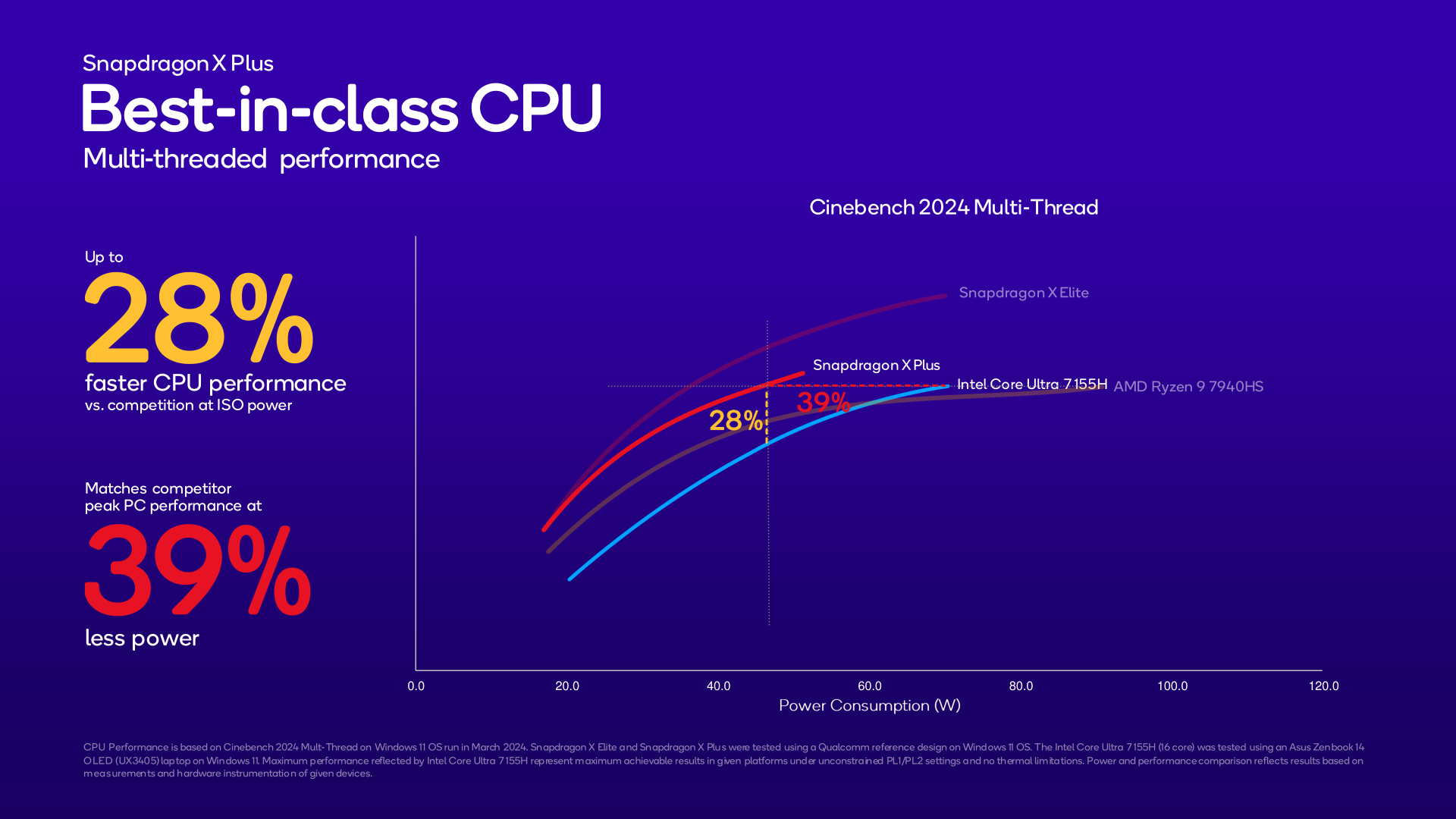
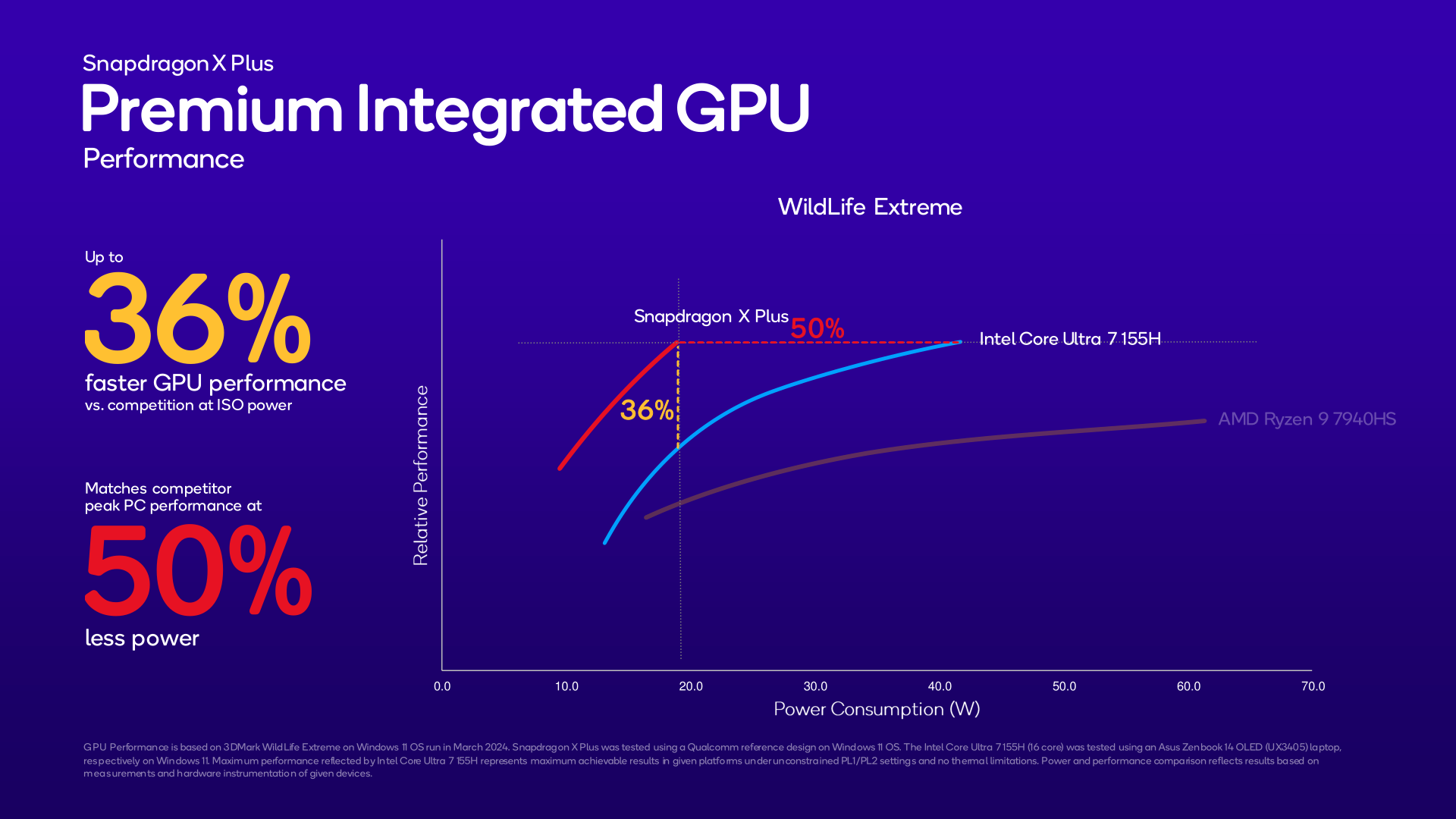







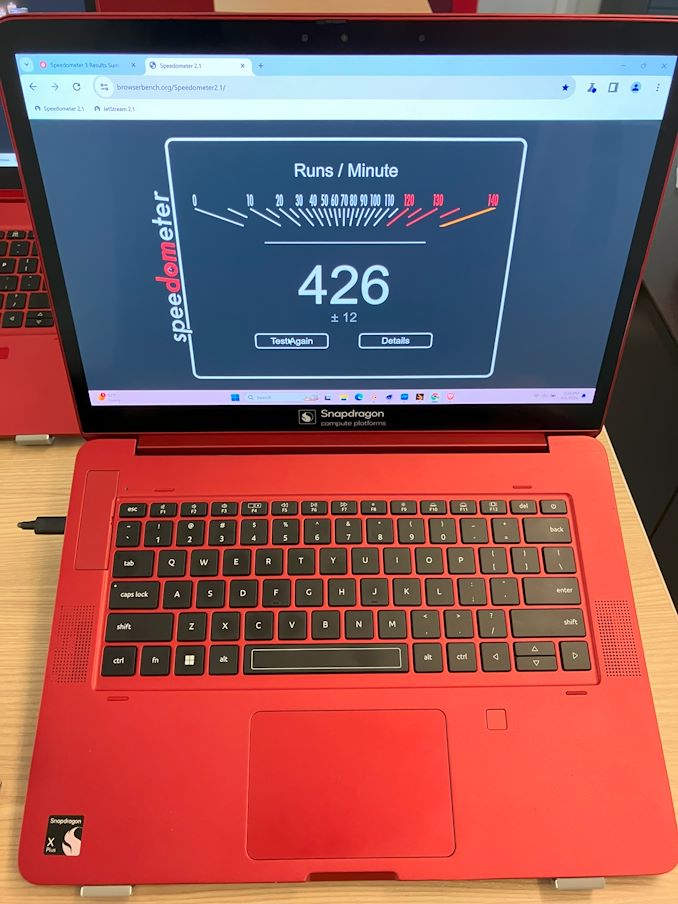
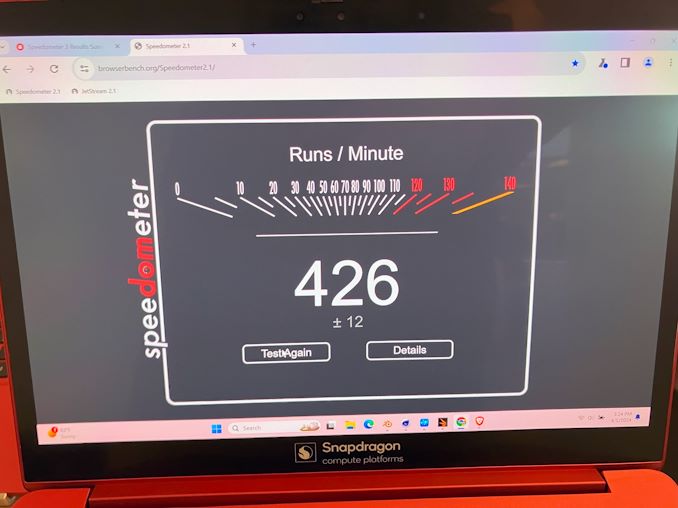
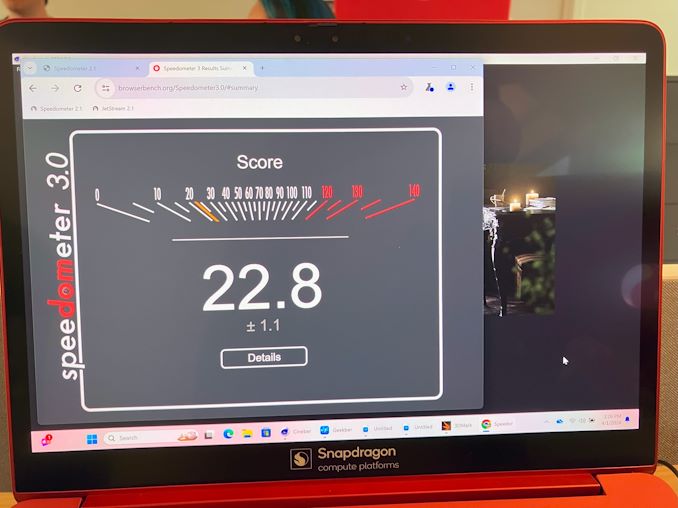









50 Comments
View All Comments
CampGareth - Wednesday, April 24, 2024 - link
Please Qualcomm and Microsoft, try to have the top end chip in some cheap, well-specced, thermally capable Intel NUC/Mac Mini form factor. I'm writing this on your Windows on ARM Dev Kit 2023 and it fit that bill very well but I'm excited to try a faster chip with better GPU drivers that doesn't break the bank or constrain performance with a low TDP. ReplyDolda2000 - Wednesday, April 24, 2024 - link
>cheapUnfortunately, one of the main issues with Qualcomm and the reason I'm not expecting much from the X Elite, is that their previous Snapdragon PC offerings have been utterly, ridiculously out of touch in terms of pricing.
Every single Snapdragon laptop I've seen has been $2,000+, and that's for a chip that can't even touch the x86 competition in terms of performance, and for a software ecosystem that one would be kind to compare even to a beta. If the X Elite is even close to the competition now, I wouldn't be surprised if it can't be found for less than $2,500, and at that kind of price, a Windows-on-ARM experience is just out of the question, and given Qualcomm's track record, I'd be impressed if it's even possible to get Linux running on it. Reply
Dolda2000 - Wednesday, April 24, 2024 - link
And to be clear, it's an utter pity that it has to be that way. I'd love myself a reasonably capable ARM laptop for development and experiments, but with the pricing and Linux support that Qualcomm seems to be set on, I don't see it happening. ReplyCampGareth - Wednesday, April 24, 2024 - link
That's why I mentioned the WoA Dev Kit, that was £600 with 32GB of RAM and a mac mini form factor. At the time the next cheapest device was a thinkpad x13s for double that. Do it again please, don't make me pay thousands for an unproven platform. ReplyAlistair - Sunday, April 28, 2024 - link
yeap give me a dev kit with 32GB/1TB for $800 USD or so Replynandnandnand - Wednesday, April 24, 2024 - link
That's the appropriate level of skepticism. Maybe the 10-core model will do better. ReplyNextGen_Gamer - Wednesday, April 24, 2024 - link
@ Ryan Smith: was there any elaboration as to the P-core/E-core split on these chips? Most rumors still say the X Elite is a 8 P-core & 4 E-core design, with the X Plus dropping down to a 6 P-core & 4 E-core. But it is well known that all cores are the "same" Oryon design. That makes me think the P/E core split is more akin to AMD's strategy with Zen 4/4C. All the cores the same, but perhaps only some can reach certain clockspeeds. At the same time though, Qualcomm is touting those 3.80GHz (or 3.40GHz) all-core turbo speeds - does that really mean all 12 or 10 cores can go that high? Is there perhaps a difference in the L2 cache between them? Or is there really no P/E core split whatsoever? Replyhigh3r - Wednesday, April 24, 2024 - link
Afaik, all cores are P cores in both Elite and Plus. 4 cores likely at lower frequency. Replydudedud - Wednesday, April 24, 2024 - link
The cores are the same, but there are two clusters. On the Elite cluster 1 has 8P cores and cluster 2 have 4P cores. On the plus the first cluster is reduced to 6P. ReplyRyan Smith - Wednesday, April 24, 2024 - link
According to Qualcomm, all of the cores are identical. They do not have separate P and E cores, though they do have multiple clusters of cores.I will put an asterisk in there though, as Qualcomm has not given us a complete deep dive on the architecture yet, and the company does not have a history of being freely forthcoming with technical details. So there could be a catch in there somewhere that makes the CPU clusters somehow different from each other.
And yes, all-core turbo is all-core turbo. All of the CPU cores can go that high, TDP permitting. Reply